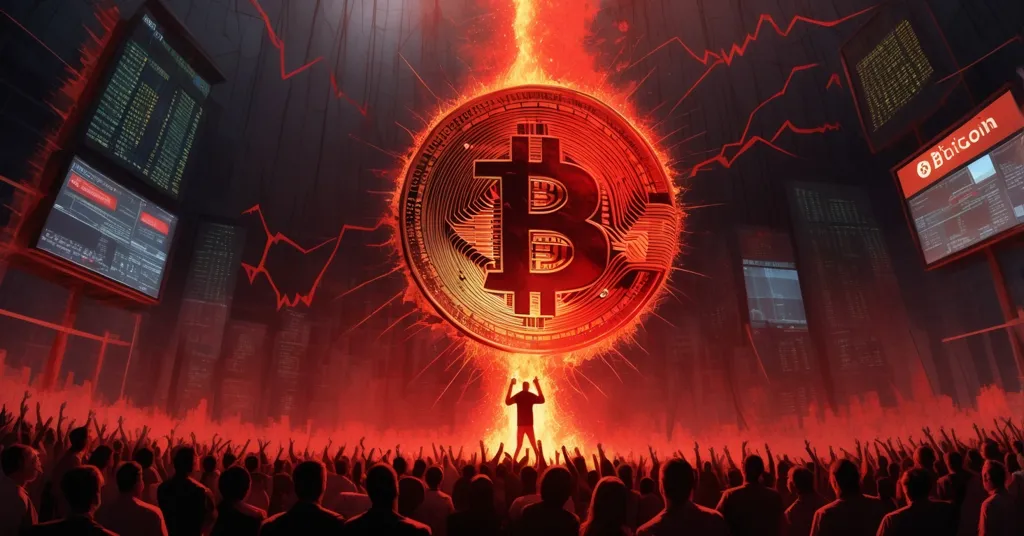Bitcoin Hits $110K: Willy Woo Warns of Greed and Profit-Taking Risks

Bitcoin’s $110K Rally: Sustainable Boom or Impending Bust? Willy Woo Raises the Alarm
Bitcoin has blasted past the $110,000 mark, setting the crypto world ablaze with excitement—but hold the champagne. On-chain analyst Willy Woo is sounding a serious warning, flagging rampant market greed and profit-taking risks that could slam the brakes on this rally, even as long-term signals scream bullish.
- Price Milestone: Bitcoin surges beyond $110,000, yet flat capital inflows spark concern.
- Woo’s Caution: Speculative mania and profit-taking could trigger a short-term crash.
- New Market Rules: Global liquidity trumps the old four-year halving cycle as the key driver.
The Rally That’s Turning Heads—and Raising Eyebrows
Let’s break down the madness: Bitcoin soared from $75,000 to over $110,000 in a jaw-dropping sprint, hitting a new all-time high even before the latest halving event. For those new to the game, a halving is a built-in mechanism in Bitcoin’s code that slashes the reward miners get for processing transactions, happening roughly every four years or after 210,000 blocks are mined. This cuts the supply of new Bitcoin entering circulation, historically igniting bull runs as scarcity fuels demand. But this time, the script has flipped. Instead of following the predictable post-halving pump, Bitcoin’s groove is now synced to something bigger—global liquidity trends—making it less of a crypto rebel and more of a Wall Street player.
Willy Woo, a heavyweight in on-chain analysis (which means he studies blockchain data to read market vibes), isn’t buying into the hype just yet. He’s pointing to a dangerous level of speculation that could spoil the party.
Woo warns that speculation is getting out of hand, with the market showing signs of greed, a classic setup for a short-term pullback.
What does that mean? When every Tom, Dick, and TikTok influencer is piling into Bitcoin expecting moonshot gains, it’s usually a signal that the early birds—those who bought low—are getting ready to sell high. Profit-taking at a psychological barrier like $110,000 isn’t just speculation; it’s a recurring theme in Bitcoin’s wild price history. Traders sitting on doubled or tripled portfolios might dump their stash to lock in profits, flooding the market with sell orders and tanking the price. Worse, capital inflows—fresh money entering the space—have stayed flat during this spike, per recent on-chain data. Without new fuel, the fire could fizzle fast. Reports from Glassnode show retail investors have been net sellers in 2024, unloading over 525,000 BTC, while institutions hoard via ETFs and funds. If U.S. markets don’t bring a wave of buyers after long weekends, bearish divergences—technical signals hinting at a price drop despite upward momentum—could creep in, cooling things down hard. For deeper insights into why Bitcoin’s price seems stuck despite the surge, the data paints a troubling picture.
A Glimmer of Hope or a False Dawn?
Not all is lost for the bulls, though. Woo dangles a carrot, suggesting that if enough buying pressure returns soon, Bitcoin could punch through to $114,000. That kind of move would annihilate short positions—bets against Bitcoin’s price that lose big when the market surges—forcing those traders to buy back in to cover losses, potentially spiraling prices even higher.
Woo believes that if enough buyers return this week, Bitcoin could shoot up to $114,000, potentially wiping out short positions.
Yet, the $110,000 level is proving to be a brick wall. Traders note Bitcoin bouncing between $106,600 and $110,700, with multiple failed breakout attempts, as reported by Cointelegraph. Analyst BitMonty spots a technical triangle pattern breakout but warns that rejection here could send prices sliding back to support zones around $106,000, or even $102,000-$104,500, as flagged by Michael van de Poppe. Macro headwinds aren’t helping either. Uncertainty over Federal Reserve interest rate moves, rising bond yields, and upcoming economic data like the PCE Index and jobless claims have traders in a holding pattern. Even political wildcards, like speeches at the 2025 Bitcoin conference in Las Vegas by high-profile figures, could jolt sentiment—past keynotes have sparked swings, including a 30% drop after a 2024 Nashville event. Without a catalyst, this rally might stall out quicker than a meme coin pump. Curious about what drives massive Bitcoin price surges like this one? The answers aren’t always straightforward.
Bitcoin’s Evolution: Goodbye Halving, Hello Macro
What’s got everyone scratching their heads is how Bitcoin’s playbook has changed. For years, its price danced to the halving rhythm: supply gets cut, scarcity kicks in, price skyrockets, repeat. Not anymore. Woo, backed by analysts like Maui Jim, argues the market has grown up, now tethered to broader financial tides.
Bitcoin is no longer behaving like it did in past bull runs… the bigger force is global liquidity.
Picture global liquidity like water in a giant pool. When there’s plenty—think central bank stimulus or loose money policies—risk assets like Bitcoin float higher as investors chase big returns. When the pool drains, the party ends. Data from Bankless shows the 2024 halving had a weaker supply shock than past cycles, and global M2 money supply growth is a pitiful 6.8% compared to 33% during the 2018-2021 mania. Add in Bitcoin’s reduced volatility—now at historic lows per Ark Invest—and the sheer capital needed to budge the price (a $250 million spot order just for a 2% nudge), and you’ve got a market acting less like a crypto punk and more like a stodgy index fund. Institutions are driving this shift too; with over $129 billion in ETF inflows locked away from altcoins, Bitcoin’s dominance over the total crypto market cap keeps climbing, a pattern unseen in earlier booms. For a deeper look at how Bitcoin’s market behavior is evolving, the shift away from halving cycles is striking.
The Tug-of-War: Speculation vs. Structural Strength
So, where does this leave Bitcoin? On one side, the long-term case remains rock-solid. It’s increasingly viewed as “digital gold” or a “chaos hedge” against global messiness—think tariff wars or policy flip-flops. Post-2024 halving, its inflation rate dipped below gold’s, cementing its appeal as a store of value for institutions, which have gobbled up nearly 900,000 BTC this year via funds and businesses, per Bankless. On the flip side, short-term risks are glaring. Flat capital inflows hint that demand isn’t matching the price hype, and waning retail euphoria—per Santiment data—could spell trouble if fresh momentum doesn’t materialize. It’s a brutal clash between speculative overconfidence and foundational strength, and only a hefty liquidity injection or a shift in sentiment will crown the winner.
Let’s not ignore the scam factor either. With Bitcoin at $110,000, every shady Telegram group and Twitter hustler is peddling fake price predictions and pump-and-dump schemes. Don’t fall for it. This space has enough real risks without adding fraud to the mix. Stick to data, not dreams, and don’t gamble your life savings on blind optimism. For community reactions to Willy Woo’s analysis of the $110K rally, the sentiment is mixed with caution.
Altcoin Angle: Bitcoin’s Dominance and Beyond
While Bitcoin hogs the spotlight, it’s worth noting its iron grip on the market is squeezing altcoins dry. With institutional cash walled off in ETFs and not trickling down to Ethereum or smaller chains, Bitcoin’s market cap dominance has been on a steady climb since 2022, currently hovering around historic highs. This isn’t the 2021 alt-season party. For non-maximalists, this raises questions: is Bitcoin’s rise sucking oxygen from innovative protocols that fill niches it can’t—like smart contracts or DeFi? On the other hand, this focus might be exactly what cements Bitcoin as the ultimate decentralized reserve asset. It’s a debate worth having, even if my Bitcoin bias leans toward the latter. For a detailed take on whether Bitcoin’s rally to $110K is sustainable per Willy Woo, the risks of a pullback loom large.
Key Takeaways and Burning Questions
- What’s pushing Bitcoin past $110,000?
Long-term buyer strength, especially from institutions piling in through ETFs, is driving the surge, though speculative mania is inflating the bubble and risks a pop. - Is this rally sustainable in the near term?
It’s shaky—Willy Woo highlights profit-taking and market overconfidence as immediate threats, though a jump to $114,000 is possible if buying pressure kicks back in soon. - Why isn’t Bitcoin sticking to its halving cycle anymore?
Global liquidity and macroeconomic forces now outweigh the traditional four-year halving model, marking a mature market more tied to central bank policies than crypto-specific events. - What happens if fresh capital doesn’t flow in?
Without new money, bearish divergences could take hold, potentially pulling Bitcoin back to support levels like $106,000 or as low as $102,000-$104,500. - Has Bitcoin outgrown its speculative roots?
It’s transitioning into “digital gold,” a hedge against global chaos, with institutional backing and lower volatility signaling a shift toward stability—though short-term swings still sting. - What macro events should we watch?
Keep an eye on Federal Reserve rate decisions, economic data like PCE Index and jobless claims, and even political speeches at crypto events—each could sway Bitcoin’s next move.
Bitcoin at $110,000 is a sight to behold, but don’t get too comfortable. We’re navigating uncharted waters where old crypto rules are dead, and macro giants are steering the ship. Whether this rally marks the dawn of a historic run or a setup for a painful faceplant hinges on shaking off speculative fever and finding real, sustained momentum. One thing is clear: in this game, overconfidence can kill. Stay sharp, track those liquidity signals, and remember—Bitcoin isn’t just a number, it’s a middle finger to fiat inflation, if it can withstand the heat.



